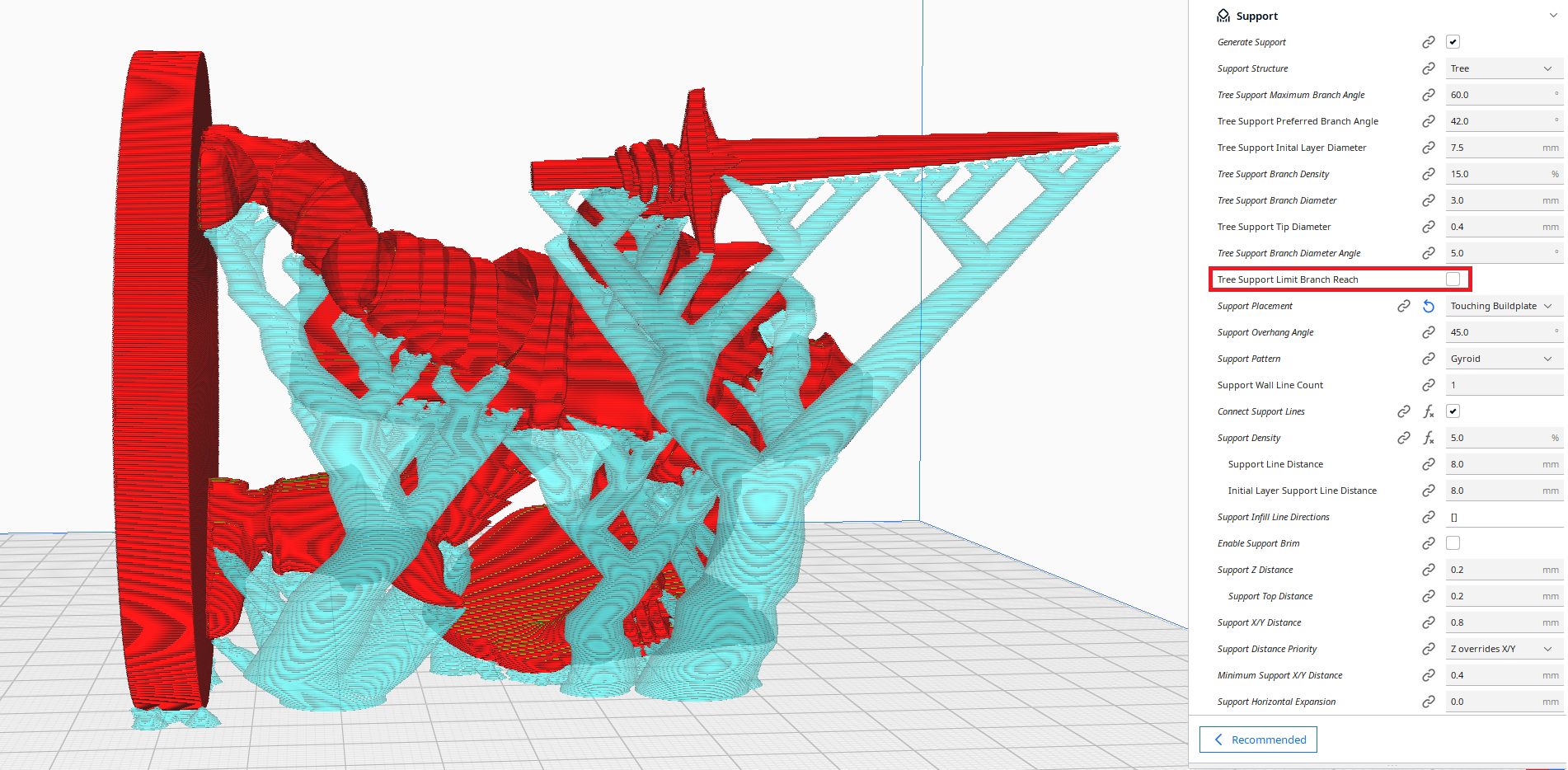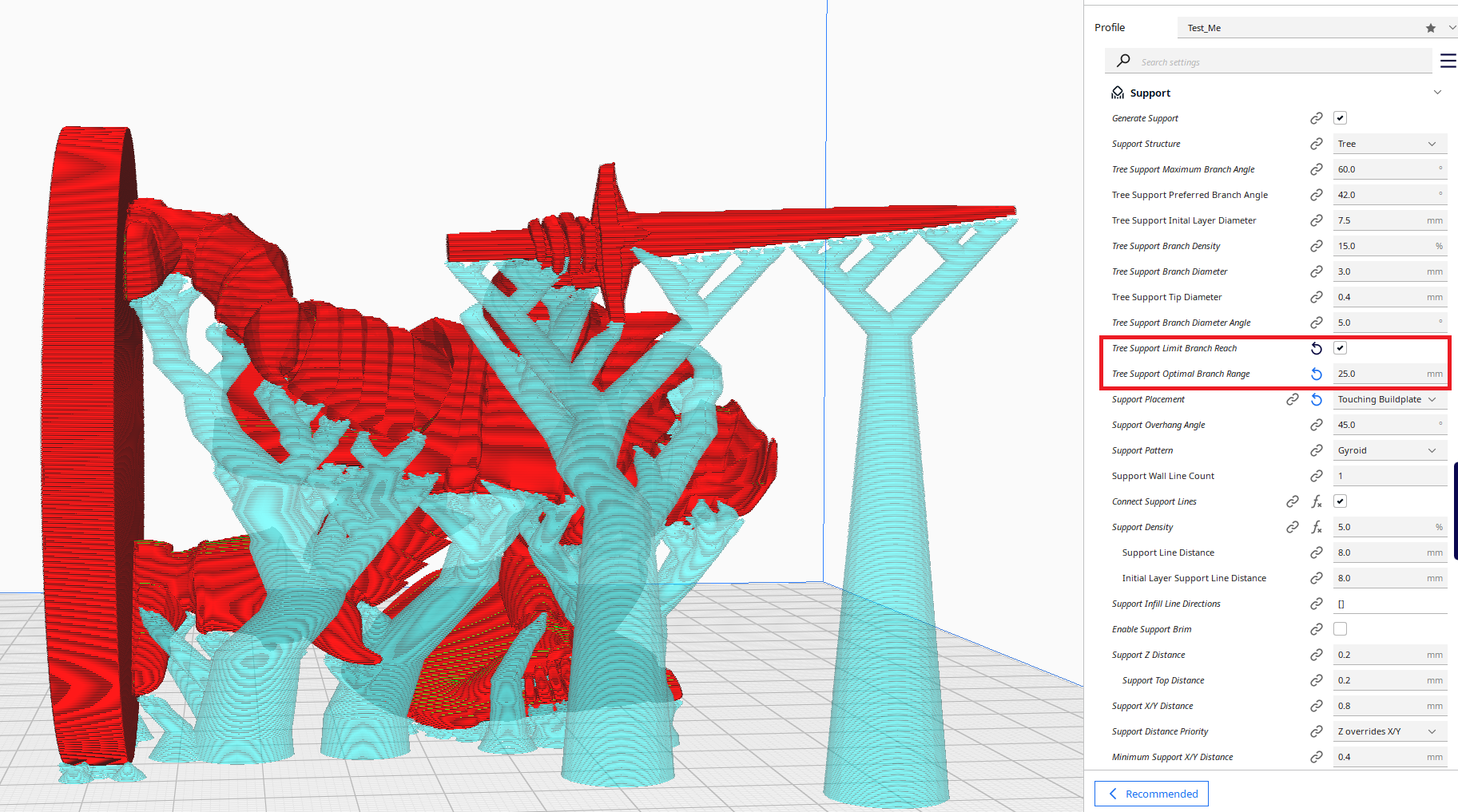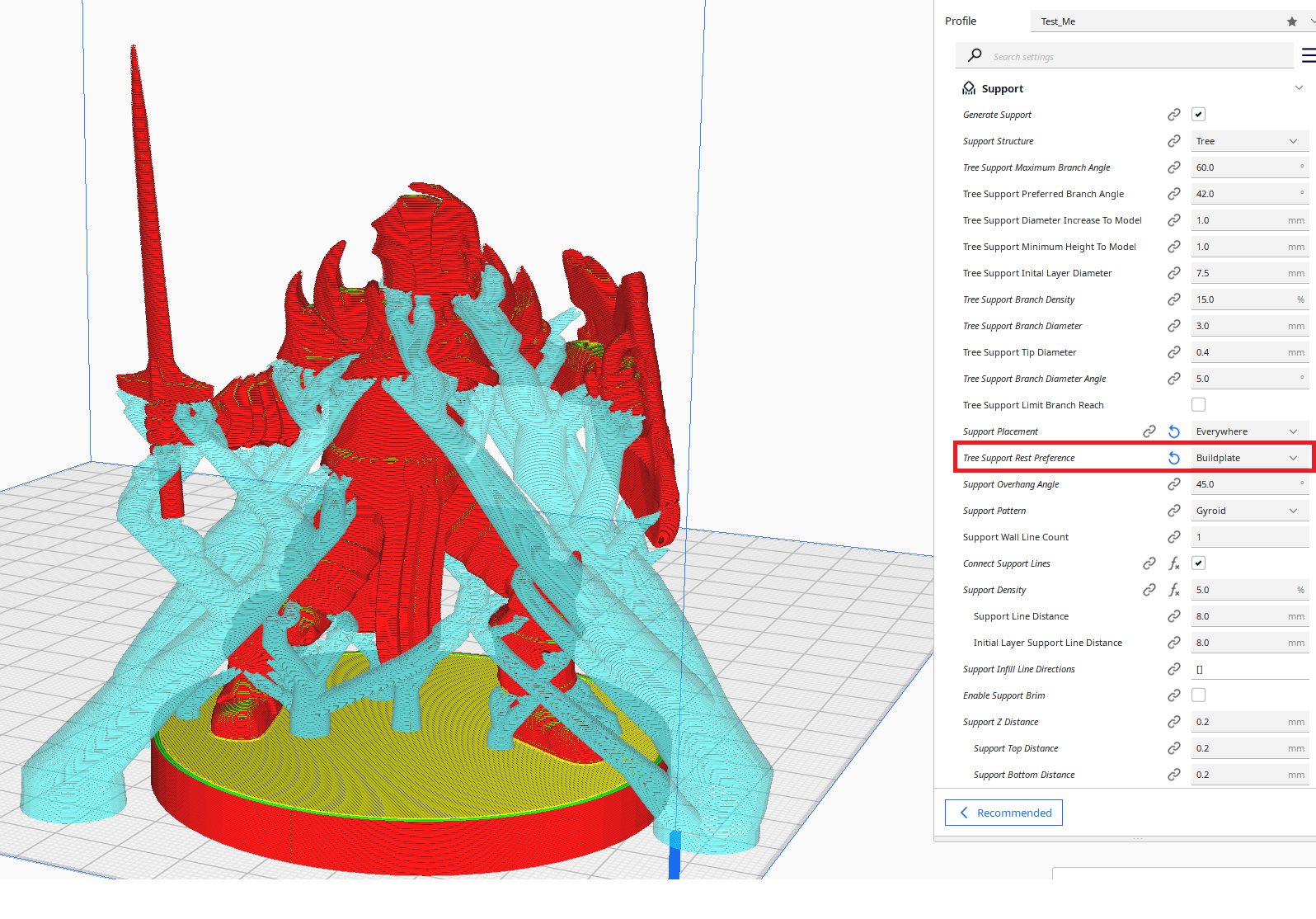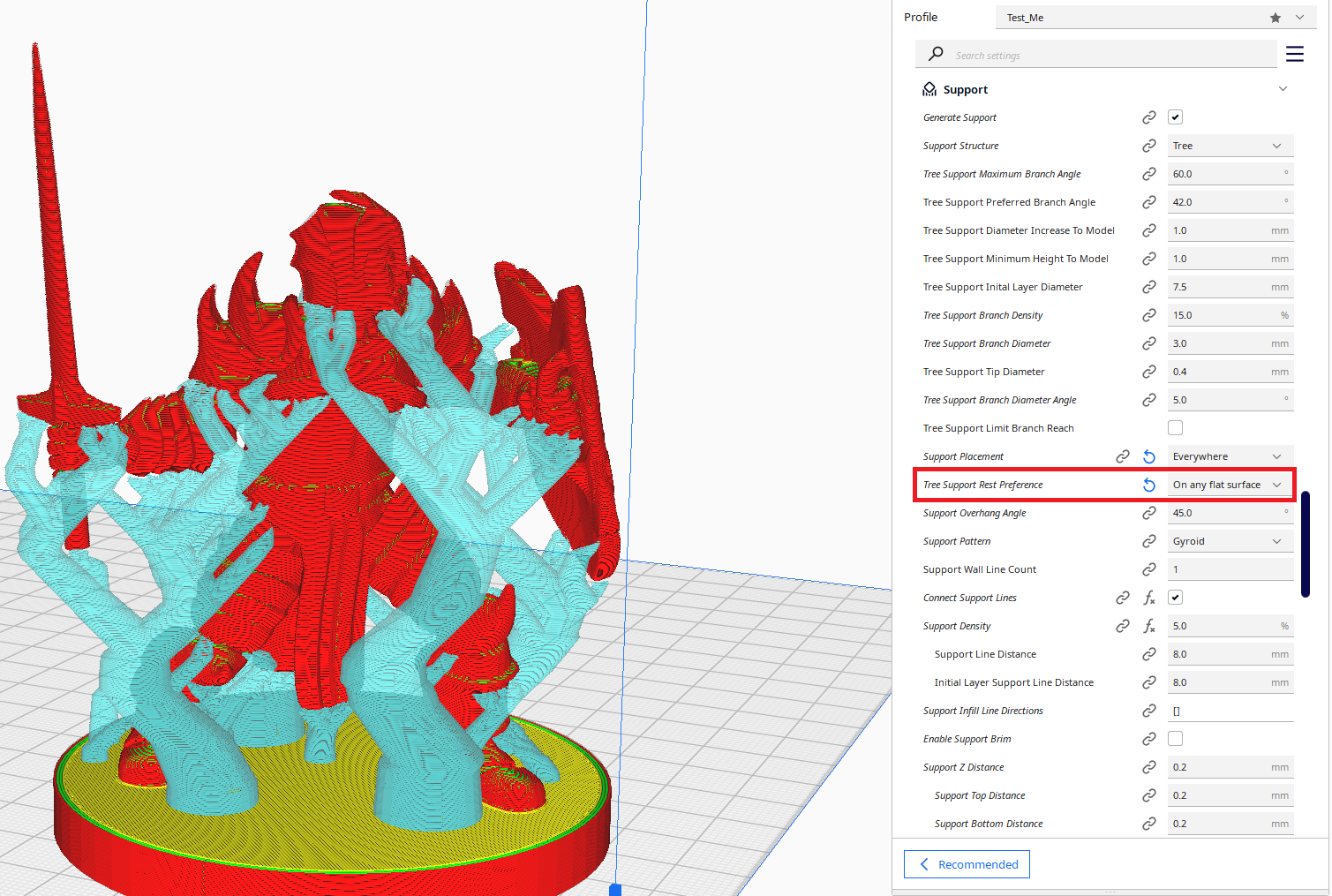-
-
Notifications
You must be signed in to change notification settings - Fork 883
New issue
Have a question about this project? Sign up for a free GitHub account to open an issue and contact its maintainers and the community.
By clicking “Sign up for GitHub”, you agree to our terms of service and privacy statement. We’ll occasionally send you account related emails.
Already on GitHub? Sign in to your account
New Tree Support Implementation #1282
Conversation
…Also fixed hole detection in projectInwardsFromOutline and a few missing new lines in log messages.
|
A couple of comments while you're working on this, to address the questions you've posed and some concerns:
We didn't review your code yet though. This is only a reaction to the description you posted on the pull request. |
|
Thank you for your feedback. Regarding the bullet points:
|
True. It's a concession we've needed to make. Our position on it has so far been that those people can stick with the old Cura version if they liked the workflow that one provided, rather than trying to pack all dozens of Cura versions in one release. |
|
On point 8, honestly it's probably easier on yourself and on the code base if you drop that feature! It's not in the expected behaviour now, and while the result will be better in the short term, if that makes the code harder to maintain in the long term it's also going to hurt. So you're welcome to try fixing it, but keep in mind that code complexity is something we'll look at too. |
…me bugs and started renaming.
…the amount of support roof layers if support roof is enabled, but the overhang area is to small for a roof.
…Distance Priority and improved to model adhesion
…with different mesh settings have a different height of the first overhang
Cura release 4.9.0
… or similar of layer 0 are requested.
|
Hi, i would like to release a version with my tree support implementation for others to be able to beta test it. |
|
No, I expect that would work fine. Maybe choose carefully which operating system(s) you'll release on. I wonder how you'll know that your Cura version is being used, though? If you get no bug reports, is that a sign that it's bug free, or that nobody found your version? |
|
I should also say that reviewing and testing 5000 lines of C++ code is no small task. Might take quite a while to get that in, especially considering there is not going to be any push from our managers to merge this, I expect. It kind of hinges on us being able to explain well why this change is necessary. |
|
Thanks for the response :) |
part of CURA-10415
…reas to be not supported. Also some small tweaks that maybe could prevent the same issue.
part of CURA-10415
# Conflicts: # include/TreeModelVolumes.h # include/TreeSupport.h
Make the minimum increase per step configurable via the class. Set to 1/2 line-width in general. Also fix for negative offset values, which this was used with all the time, which my earlier div-by-0 stopgap-fix didn't take into account. CURA-10464
Also don't rely on fudge-length anymore, make dependant on 1/2 line-width. I don't think this function is supposed to take negative offsets, like the other one, but please check my assumption in review. CURA-10464
It doesn't really matter that much that the branches are circular, as long as they are circular 'enough'. Given the gigantic number of branches a model may have just under a large overhang, unioning these circles takes a long time. CURA-10464
The cipper union algorithm seems to be written for a small number of complex polygons, rather than a large number of simple ones. This workaround seems to work very well in case there is, say, a large number of mostly overlapping circles that need to be unioned that where added to a single Polygons object. CURA-10464
CURA-10464 Co-authored-by: Casper Lamboo <c.lamboo@ultimaker.com>
[CURA-10464] Tree Support 2.0 speed-ups
Quick test to see if Scripta works on this branch [CURA-10415]
[CURA-10415]
…e branches). This includes porting a function from PrusaSlicer that intersects a Polygon with an AABB. Fixed a small bug related to line orientation for simulated support lines.
…interface is disabled.
…orm a lower density structure below it instead of placing tips directly below the rooflines (which could cause tip-areas to merge, causing nothing to be supported)
Tree Support V2
I reimplemented the tree support, as the current implementation does not meet my expectations.
I have a fork where a compiled version of a Cura with this Tree Support modification can be downloaded.
How the new tree support looks:
Feedback I have gotten recently
"I just want to thank you for these. With your stock settings I am getting amazing results . As someone coming from Prusa/superslicer , and new to any version of Cura, i'm shocked that supports can come off this cleanly , and leave no trace on the print."1
"I've been having a bunch of issues with the Main Cura tree supports not properly getting all of my overhangs, I just installed your fork and it looks like a vast improvement! "2
"The tree supports in Cura create a massive trunk that can surround whole parts in some cases, I always wanted a tool to cut archs out of those trunks to reduce the amount of filament wasted, or an arch-shaped blocker that would achieve the same result, but your tree supports seem to achieve a similar result"3
"What you've done here is awesome work, and I thank you for it."4
"I want to show to all of you the good work of this mod, in my opinion it is a good support way."5
"I'm still using this as my daily and tbh I think it's a shame it's getting slept on by not just Cura but the likes of prusaslicer/superslicer/etc. It's so much better than the stock Cura tree supports"6
Currently known issues:
Minimum Support X/Y Distanceis larger thanSupport X/Y Distance. This can trigger an error message if the version displaying them is used. I will not fix this one, except by maybe disallowing it in the UI, as I think the assumption that a minimum is not larger than the expected one is reasonable.Settings:
Recommended settings
To see the tree support specific settings set the
Setting Visibilitytoall.I recommend enabling roofs and setting a reasonable
Minimum Support Roof Area(I use 10 mm²). My implementation will make sure to correctly support the lines generated by the support roof. If no roof is possible the branches will try to avoid moving for as many layer as the roof is thick. They will generate as regular tree support branches, as i have serious doubts about the stability of roofs in branches.Do not use concentric floor. It will generate as intended (by my understanding at least), but I suspect it will not print (it will be obvious when you see it) when support infill is low.
Set
Minimum support areato 0, higher values may cause very pointy overhangs to not be supported (as intended by my current understanding of this feature)New Tree Support Settings
The changes for the
fdmprinter.def.jsoncan be found here.Tree Support Preferred Branch Angle vs Tree Support Maximum Branch Angle
Tree Support Maximum Branch Angleis ONLY used whenTree Support Preferred Branch Angleis not enough to avoid the model. This causes branches to only move withTree Support Preferred Branch Angleto merge with other branches.Idea behind this is that
Tree Support Preferred Branch Angleis a very stable angle, but if some parts could not be supported with the smaller angle the larger angle can be used to reach these parts.Tree Support Diameter Increase To Model
Branches that can reach the buildplate and branches that cannot are able to merge. This setting limits how much the diameter of the branch connecting with the model can be increased by such merges.
This setting is intended to specify how important it is that connections with the model are avoided (the lower this setting, the less contact area with the model).
Small Diameter Increase To Model:

Large Diameter Increase To Model:

Tree Support Minimum Height To Model
If only a few layers space are left between the position where the branch begins and where it ends, removing the support is impossible. This setting removes all branches that have a height lower than
Tree Support Minimum Height To Modelto prevent this. Only branches that rest on the model are removed.Small Minimum Height To Model:

Large Minimum Height To Model:

Tree Support Initial Layer Diameter
Branches try to ensure to reach this diameter at layer 0.
Small Initial Layer Diameter:

Large Initial Layer Diameter:

Tree Support Branch Density
A percentage of space that has to be filled by the top most layer of a branch aka the layer that supports the overhang. When a roof is supported the overhang is the line of the roof. When no support roof is used it behaves similarly to the supporting (top most) layer when using regular support. High values (depends on your other settings) of >35% can cause the resulting support areas to overlap. This causes cura to merge them to a single area, as cura assumes every support area is supported by support areas below. If a low support infill is used this assumption is wrong. There is nothing reasonable I can do to prevent this, so in this case adjust your support infill accordingly.
Simulated regular support pattern:

Tree Support Tip Diameter
Defines the diameter of the top most support area of a branch.
Using a large diameter without having a reasonable large support density would obviously not print well.
Can replace tips with roof!
Happens automatically when
Minimum Support Roof Areais smaller than a circle with diameterTree Support Tip Diameterand roofs are enabled.Large Tip Diameter with minimum roof area being small:

Large Tip Diameter with minimum roof area being large:

Small Tip Diameter:

Large Tip Diameter:

Support Interface Priority
This setting defines how support roof and regular support (e.g. from other branches) interact.
Support preferred(Support Area Overwrites Interface Area):

Interface preferred(Interface Area Overwrites Support Area):

Support lines preferred(Support Lines Overwrite Interface Area):

Interface Lines preferred(Interface Lines Overwrite Support Area. This one will not be what you want when Support Wall Count > 0):

Both Overlap (This causes filament be extruded twice at the same location (Once the support and once the roof). This may cause issues when printing. Use with care!):

Tree Support Limit Branch Reach and Tree Support Optimal Branch Range
Limit how far each branch should travel from the point it supports. This can make the support more sturdy, but will increase the amount of branches. Branches can violate this value to reach their destination.
Tree Support Limit Branch Reach Disabled:


Tree Support Limit Branch Reach Enabled with a small distance:
Tree Support Rest Preference
The preferred placement of the support structures. Note that the buildplate is assumed to be also a flat surface (If not i think you have bigger issues than this setting)!
Only visible when the support can rest on the model.
Buildplate:


On any flat surface:
Tree Support Branch DiameterandTree Support Branch Diameter Anglebehave like in the current tree support implementation, butTree Support Branch Diameter Angleis ignored when a diameter increase would invalidate a branch, as a small branch has a higher chance of supporting the model than no branch at all.What does it do better:
Uses significant less filament.
Also makes the branches of my implementation much easier to remove from the model.
Current tree support:

My tree support:

Comparison of material usage:

Disclaimer: This is only the material used for support structures, not the whole model. The measuring unit is mm of 1.75mm diameter filament, as displayed in Cura. Measurement was done in the 4.7.1 version, and exact numbers could differ slightly.
Can handle large branch angles.
Current tree support:

My tree support:

Supports Roofs more consistently.
The images show the bottom-most roof layer and a few layers of the branches below. In the current tree support some lines of the roof have a large distance from one point where support is below it to the next. My implementation ensures consistent spacing.
Current tree support:

My tree support:

Branches avoid support blocker.
Setting applicable now on a per-mesh basis.
All tree support related settings are now settable per mesh and support related settings are correctly used by the tree support. This may increase slicing time drastically for settings that are not only relevant on the top most support layers.So to avoid slicing times being longer by factor 10 try not to slice 10 different models with different branch radii (Slicing 2 models with different settings should not take much longer than slicing 2 times).
Trees with settings that are incompatible with each other can not merge and will avoid each other.
Few settings differences allow merges:

More settings of the regular support are now supported by the tree support
The newly supported settings are:
Support Distance Priority,Support Horizontal Expansion,Support Interface Horizontal Expansion,Minimum Support Roof Area(Some of these were enabled in the UI, but did not do anything if I understand the code correctly) andMinimum Support Area(though I would recommend leaving this setting at 0).Slices faster on multicore cpus.
Measured was the time it takes to generate the tree support for the test model (hobgoblin).
Settings used for benchmarking:
Profile for current tree support
Profile for my tree support implementation
Benchmarking was done in the 4.10 Version.
Further attributes this implementation has:
If a model is sliced twice on the same machine, the same trees will result. If this is somehow not the case something went very wrong. (Trees generated on systems with a different amount of threads could theoretically differ).
Every point that can be supported with the given Branch Angle limitations, will be supported when the support can only rest on the build plate. This means some other settings may be paused to ensure such behavior. For example:
Tree Support Branch Diameter Anglewill be paused if a radius increase would cause a branch to become invalid.How the algorithm generating the trees works
This explains the idea behind the algorithm. As such it is simplified a fair bit to avoid explaining fixes for some edge cases.
0. The model
1. Calculate avoidance
An avoidance is an area that has to be avoided to achieve certain given results. For example an area in which a branch would be unable to reach the buildplate has to be avoided, if the support is not allowed to rest on the model. This idea is identical to the current tree support. My implementation just uses a lot more avoidances(slow, fast, slow to model, fast to model, fast without holes, fast without holes to model), and precalculates them in parallel. Avoidances are calculated from the bottom up.2. Generate influence areas
An influence area is an area,in which every point of the represented current branch, can reach all support points it has to support. Is is similar to an avoidance, but other that the avoidance, it represents possible center point areas, rather than excluding impossible ones. If two influence areas intersect, only the intersection will be used going forward. This causes branches to merge. Influence areas are calculated from the top downwards, as they grow from the overhang downwards.3. Generate tree path
Using the influence areas, the center points of the circles that build the branches are set. This happens from the bottom up.4. Draw Tree
The circles, which center-point was calculated in 3. are drawn. Here also happens a fair bit of post processing to avoid edge-cases by the fact that the drawn radius in the tip of a branch is always increased (for stability reasons), even if a normal circle would not fit.Possible future improvements:
Automatically increase branch height when the angle is large.
Further Information
I did not make the mini hobgoblin I used to test. I used it because it cloak makes it very hard to slice in a way that the cloak is supported while not having a connection of the branch to the model.
All screen-shots of the current tree support were made using version 4.7.1.
Thank you to DerGenaue for providing the images explaining the algorithm and creating the graphs out of the performance data.